Von Thunen’s model of Agricultural Location | Geography Optional for UPSC PDF Download
Introduction
The agricultural location theory is a normative economic model that was first presented by Johann Heinrich von Thünen, a Prussian landowner, in 1826 in a book called Der Isolierate Stat (Isolated State).
This theory is based on the concept of Economic Rent which is prevalent in farm market distance relationships. The agricultural location theory is one of the earliest attempts to explain the pattern of land use in economic terms which was proposed by Von Thunen.
Von Thunen’s location theory on agriculture is based on the study of an agriculture field in Germany. In this model, Von Thunen explains the crop productivity and land use pattern changes when we go away from the market.
The main aims of the Von Thunen Model of Agriculture were to explain why and how agricultural land use pattern varies when we go away from the market. It also explains the hierarchy of agricultural crops based on profit-making capacity.
First, the following basic terminology needs to understand to a better understanding of the model.
- Crop productivity: It is measured by the ratio of agriculture output to the input of per unit agriculture areas.
- Crop intensity or intensive farming: At least two or more crops are grown a year of particular agricultural land. In these methods, the large lever of inputs such as money, fertilizer, and labor are used to get a high yield per unit of agricultural land.
- Extensive farming: Less than two crops in a year are cropped in a larger agriculture area with a lower yield. Low level of inputs applied as compare to intensive farming.
- Mixed cropping: Growing two or more crops simultaneously on the same piece of land. For example, wheat + gram
- Hinterland: It is an isolated region that is away from the coastline or river.
- Isolated state: The land is completely flat having equal soil fertility & climate and has no river or mountain.
Economic rent – Economic rent is defined as the net income accruing to an area of land above the net income of land at the economic margin of production. The economic rent of a crop increases if the location of agricultural land is near the market due to less transportation cost. Von Thunen’s concept of economic rent is also known as locational rent since the economic rent is estimated by the location of agricultural land.
Basic Assumptions in the Von Thunen Model
- The isolated state comprises of one market area and an agricultural hinterland.
- The market receives goods only from the hinterland and the hinterland sells goods only to the market.
- The hinterland ships its surpluses to no other market except the city.
- There is a homogeneous physical environment, including a uniform Plain around the City.
- Farmers are settled in the hinterland who wish to maximize the profit.
- There is only one mode of transport that is horse wagon is used.
- Transportation cost is directly proportional to distance. The higher the distance higher the transport cost.
He had two basic postulates
- The intensity of the production of particular crop declines with the distance from the Market. Here the intensity of production means the amount of inputs per unit area of the land.
- The type of land use will vary with distance from the Market.
Using these two principles and basic assumptions, the model tried to give the optimal land use pattern which will give farmers maximum profit or rent. Since a farmer is an economic person and hence they will farm those crops which will give more total profit or rent.
He observed that particular activities were focused in certain zones around the center, ideally this would then lead to a system of concentric rings with every ring specializing in different agricultural activities based on transportation costs, weight, and Perishability.
Von Thunen developed an agricultural location model with 2 prominent parts- Agricultural land use and economic rent.
Economic Rent
Few geographers later termed it as locational rent as well. This is the basic principle of Thunen’s analysis, where he argued that different types of land use produce different net returns per unit area. The price a farmer obtains can be calculated easily- the price at the market minus the cost of transporting it to the market.
Economic rent is the measure of the advantage of one piece of land over another. Since all farmers receive the same price at the market and production costs are also assumed to be the same, the only advantage one piece of land has over another is its location from the market. So, if it’s closer to the market its locational rent is higher and it reduces with the distance from the market i.e.
LR= Y (m-c) – Ytd,
Where LR= locational rent per unit of land,
Y= yield per unit of land, m= market price per unit of land,
c= production cost per unit of product,
t= transport rate per unit of distance,
d= distance from the market.
Von Thunen theory of agricultural location
- Intensity Theory
- Crop theory
Intensity Theory
Due to the rise in transportation cost, intensive cultivation is most suitable near the city centre. Therefore, the intensity of production of a particular crop declines with distance from the market.
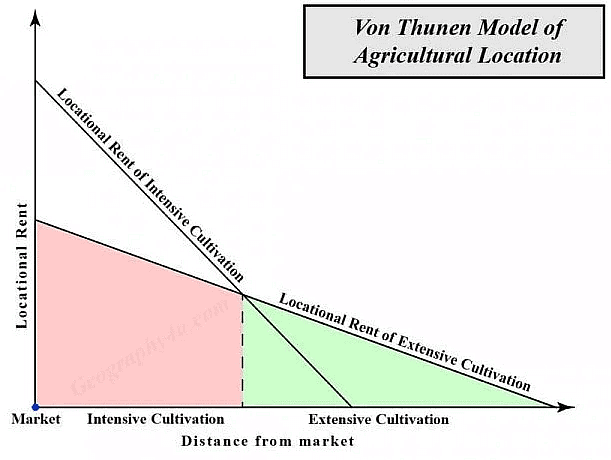 Crop Intensity Von Thunen
Crop Intensity Von Thunen
Crop theory
According to crop theory, there will be a variation in the land use with distance and the factors responsible for the variation in the land use pattern are market price of a particular crop, transportation cost, production cost and yield per unit of land. The crop theory of Von Thunen can be understood by taking the following two cases.
 Crop Intensity Von Thunen
Crop Intensity Von Thunen
Case- 1: When two crops P and Q have the same production cost and yield but having different transport costs and market prices. If P is costlier to transport and has a higher market price then crop P will be grown closer to the market than Q. Due to the higher transportation cost of crop P, the location rent of P decreases more rapidly.
Case- 2: When two crops X and Y have the same production and transportation cost (per tonne/km) but different market price and yield per unit of land. If X has a higher yield and lower market price than Y, it will be grown closer to the market than Y.
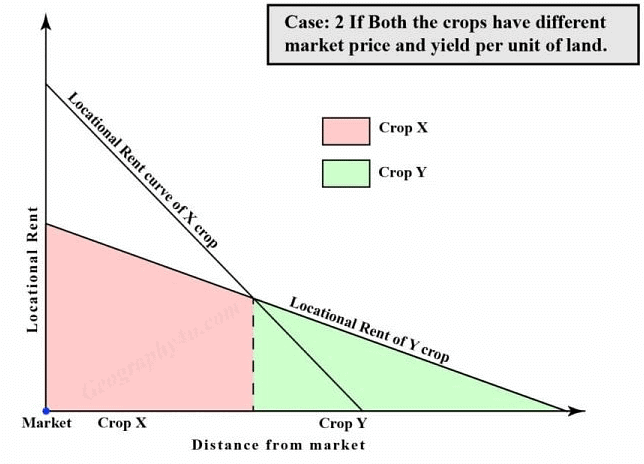 Crop Theory Von Thunen
Crop Theory Von Thunen
Concentric zonal rings of agricultural production
Von Thunen recognized following six concentric zonal rings of agricultural production.
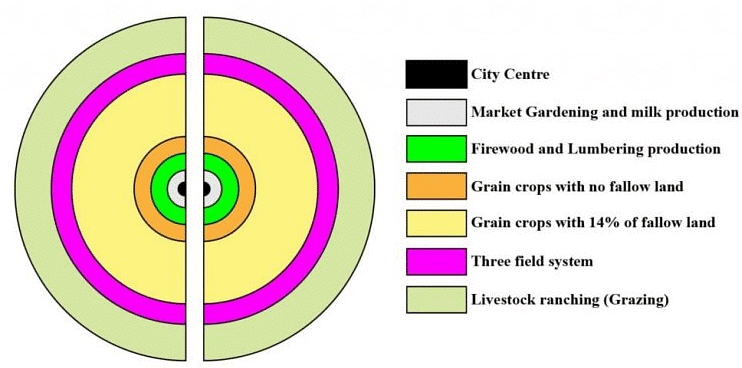
Zone-1: Market Gardening and milk production
Zone-1 would be dedicated to cash cropping. Due to deficiency of food preservation facilities, primitive modes of transportation, and the highly perish nature of products, market gardening, and milk production were most suitable in this zone.
Zone-2: Firewood and Lumbering production
The second zone was marked by the production of firewood. Due to heavy bulkiness and primitive transportation modes, wood was comparatively costly to be shipped. It was also used as a fuel and building material. However, the outer limit of this zone was marked by wood which was highly in demand in the market.
Zone-3: Grain crops with no fallow land
Unlike zone-2, the zone-3 was marked by food grains. Rye was the most important market product of this zone, having no fallow land. The cropping intensity of this zone was highest as compared to zone-4 and zone-5. Most importantly, grains could be stored, easy to transport and last longer than milk products. Also, the agricultural land would be cheaper farther away from the market.
Zone-4: Grain crops with 14% of fallow land
This zone was marked by 14% of fallow land, having less crop intensity as compared to zone-3. The farmers of this zone usually practised seven years crop rotation with one year each rotation of rye, barley and oats, three-year rotation of pastures and one year as fallow land.
Zone-5: Three field system
Like zone-2, this zone was marked by extensive cultivation having 33% of land as fallow. The farmers of this zone practised three-field system, having 1/3rd of land as crop field, 1/3rd as pastures and rest left for fallow land.
Zone-6: Livestock ranching (Grazing)
The market products of this zone would be of two types namely, livestock and by-products of milk like cheese, butter, etc. which would not highly perishable. Also, the reduction in the volume of these by-products made them cost-effective in terms of transportation.

Modifications in Von Thunen model of agricultural location
Von Thunen himself considered the potentially distorting effect of improved transportation routes as navigable waterways, roads, and railways on which transportation was speedier and costs only about one-tenth (along waterway) that of land transportation.
As important cities generally have access to a navigable waterway, Thunen introduced a stream into his “Isolated State” resulting in the elongation of the production zone roughly along the stream.
Zone-1 was least changed in shape; zone -2 extended in a narrow band for some distance in each direction from the city, but it was no longer an enclosed zone and instead of approaching close to the town it seems more likely that woodlands would have been situated at some distance up and down the stream.
Since the transportation cost of wood was very high vis-a-vis its value; the river-side location was the most favoured location for this form of production.
The provision of only “one market” was also subsequently removed by Von Thunen. The consideration of a minor market center with its own small tributary area apparently with the production of Zone-1 type opens up the possibility of numerous towns of roughly equal importance with intermingled production zones that modify each other. This leads towards the extreme complexity in the real world where the zonation around the individual cities is rudimentary or indistinguishable.
The following are the modification introduced in the classical model of Von Thunen.
- Introduction of a navigable river into his Isolated State.
- Elongation of production zones along the river.
- Extension of Zone-2 in a narrow band.
- Consideration of more than one market center or minor market centers.
- Possibility of numerous small towns of equal importance.
- Intermixing of production zones due to numerous towns.
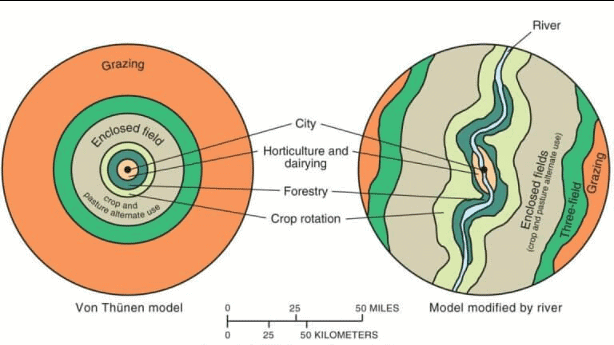
Modifications in Von Thunen model of Agricultural Location
Critical Analysis
The theory of agricultural location was presented by von Thunen in the early 19th century. Since then, several scholars including geographers have applied it in various parts of the world and have pointed out certain aspects that are not applicable in a way as pointed out by von Thunen.
Many aspects of this model have changed due to development in the agricultural systems, transportation system, and also due to other technological developments. There are also certain regional geo-economic factors that not only direct but determine the pattern of agricultural land use.
The main points raised by scholars regarding this theory are as follows:
- The conditions described in this model, i.e., in an isolated state, are hardly available in any region of the world. There are internal variations in climatic and soil conditions. Von Thunen’s assumptions that there are no spatial variations in soil types and climate are rare.
- It is not necessary that all types of farming systems as described by von Thunen in his theory exist in all the regions. In many European countries location of types of farming in relation to the market are no longer in existence.
- Thunen’s measures of economic rent and intensity are difficult to test because of their complexity. The measurement of the number of man-days worked in a year, the cost of labour per hectare, or the cost of total inputs per hectare is not uniform in intensive and extensive types of farming. Similar is the case with the measures of intensity,
- Von Thunen himself has admitted that with the change in location of transportation or market center the pattern of land use will also change.
- The location of the transport link and its direction used to change the pattern of agricultural land use is depicted in Figure.
- Similarly, if there are two market centres, the pattern of land use will be according to Figure below
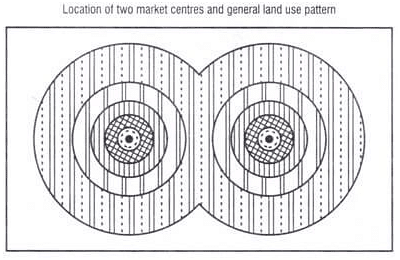 Two market centre
Two market centre
- The situation will be entirely different when there are several market centres in a region.
- During the past 190 years, there have been sizeable changes in agricultural land use and the economy with which it interacts. The most important of the changes have been improvements in transportation technology; these improvements now permit a space-time convergence of distant places, thereby expanding the scale of possible economic organization. In von Thunen’s day, heavily loaded horse-drawn carts moved to market at the rate of about 1 mile an hour.
- The von Thunen model is also static and deterministic. Today, we know that economic growth and changes in demand will alter the spatial patterns of agricultural systems and land use, which in turn influence the rate of change. It might be possible to postulate a dynamic von Thunen model that could be applied to the changing conditions.
- But, the model, despite these possible manipulations, is really static, since, it represents a land-use system at one point in time, Von Thunen was not concerned with transitional changes, since, he and most of the direct extenders of his model assumed that any change in technology, demand, or transport cost would automatically be accompanied by an adjustment in the land-use system.
The Von Thunian model was developed in the early 19th century, since then, conditions have entirely been changed. Therefore, it is not desirable to accept this model in its original form as observed by many scholars. But this model is still considered to be significant in many ways.
|
303 videos|636 docs|252 tests
|
FAQs on Von Thunen’s model of Agricultural Location - Geography Optional for UPSC
| 1. What is Von Thunen's model of agricultural location? |  |
| 2. How does Von Thunen's model explain the spatial distribution of agricultural activities? |  |
| 3. What are the key assumptions of Von Thunen's model? |  |
| 4. How does the Von Thunen model relate to real-world agricultural practices? |  |
| 5. What are the limitations of Von Thunen's model? |  |
















